Francesco Hayez stands as a monumental figure in the landscape of 19th-century European art, particularly as the leading exponent of Romanticism in Italy. His long and prolific career, spanning from the twilight of Neoclassicism to the full bloom of Romantic expression and beyond, charts a fascinating journey through the artistic and political currents of his time. Born in Venice and ultimately making Milan his artistic home, Hayez's canvases are celebrated for their emotional depth, historical resonance, and exquisite technical skill. He was a master of historical narratives, a sought-after portraitist, and an artist whose work became intrinsically linked with the burgeoning spirit of Italian unification, the Risorgimento.
Early Life and Venetian Foundations
Francesco Paolo Hayez was born in Venice on February 10, 1791, into a family of modest means. He was the youngest of five sons of Giovanni Hayez, of French origin, and Chiara Torcella, a native of Murano. His early life was marked by financial hardship, but his innate talent for drawing was recognized early on. His maternal uncle, Giovanni Binaso, an art dealer and restorer, took the young Francesco under his wing, providing him with his initial exposure to the world of art. This early apprenticeship involved learning the craft of art restoration, which would have given him an intimate understanding of the techniques of past masters.
His formal artistic education began under Francesco Maggiotto, a respected Venetian painter, with whom he studied for about three years. Maggiotto's studio would have provided Hayez with a solid grounding in traditional painting techniques. Subsequently, in 1806, he was admitted to the New Academy of Fine Arts in Venice (Accademia di Belle Arti di Venezia), where he studied under Teodoro Matteini. Matteini, a proponent of Neoclassicism, would have instilled in Hayez the prevailing aesthetic ideals of clarity, order, and idealized form, heavily influenced by the works of artists like Jacques-Louis David and Anton Raphael Mengs. During his time at the Venetian Academy, Hayez demonstrated exceptional promise, distinguishing himself in various competitions.
Roman Sojourn and Neoclassical Ascendancy
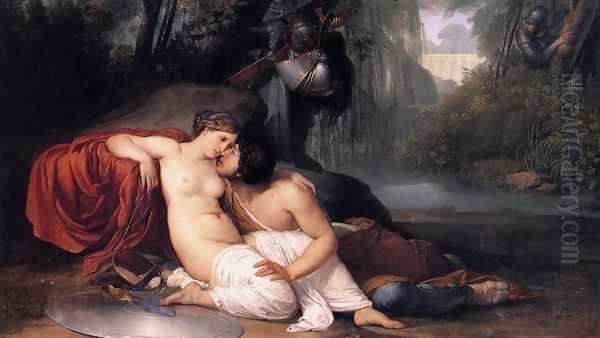
In 1809, Hayez won a prestigious scholarship from the Venetian Academy, which enabled him to continue his studies in Rome, the epicenter of Neoclassical art. This move was transformative. In Rome, he became a protégé of the renowned Neoclassical sculptor Antonio Canova, who was a dominant figure in the European art scene. Canova, also of Venetian origin, took a keen interest in Hayez, offering guidance and support. Under Canova's influence, Hayez further honed his Neoclassical style, focusing on mythological and classical historical subjects. He also frequented the studio of Pelagio Palagi, another artist who, like Hayez, would navigate the transition from Neoclassicism to Romanticism.
During his Roman period, Hayez immersed himself in the study of classical antiquity and Renaissance masters, particularly Raphael. His works from this era, such as Laocoön (1812) and Rinaldo and Armida (1812-1813), reflect the Neoclassical emphasis on heroic themes, clear composition, and idealized human figures. He also associated with other prominent artists in Rome, including Jean-Auguste-Dominique Ingres, whose meticulous draftsmanship and refined classicism would have offered another point of reference. However, even within these Neoclassical frameworks, hints of a more emotive and dramatic sensibility began to emerge in Hayez's work, foreshadowing his later Romantic inclinations. His painting Ulysses at the Court of Alcinous (1813-1815), for instance, while adhering to classical subject matter, displays a richness of color and a burgeoning interest in human emotion.
The Move to Milan and the Embrace of Romanticism
After a brief period in Naples, where he was commissioned by Joachim Murat, the King of Naples, Hayez eventually settled in Milan around 1820. Milan, at this time, was becoming a vibrant cultural hub and a center for the burgeoning Romantic movement in Italy. This environment proved to be fertile ground for Hayez's evolving artistic vision. The Italian Romantic movement, while sharing some characteristics with its counterparts in France (led by figures like Eugène Delacroix and Théodore Géricault) and Germany (with artists such as Caspar David Friedrich), had its own distinct flavor, often intertwined with patriotic sentiments and the desire for national unification.
In Milan, Hayez quickly established himself as a leading figure. He began to move away from purely classical themes, increasingly drawing inspiration from medieval history, literature (especially the works of Sir Walter Scott, Lord Byron, and Italian authors like Alessandro Manzoni and Tommaso Grossi), and contemporary events. This shift was pivotal. His painting Pietro Rossi, Lord of Parma, Imprisoned by the Scaligeri (1818-1820), exhibited in Milan in 1820, is often considered a seminal work of Italian Romanticism. The painting depicts a dramatic historical scene, emphasizing pathos, individual suffering, and patriotic virtue, resonating deeply with the contemporary Italian audience yearning for national identity and freedom from foreign domination.
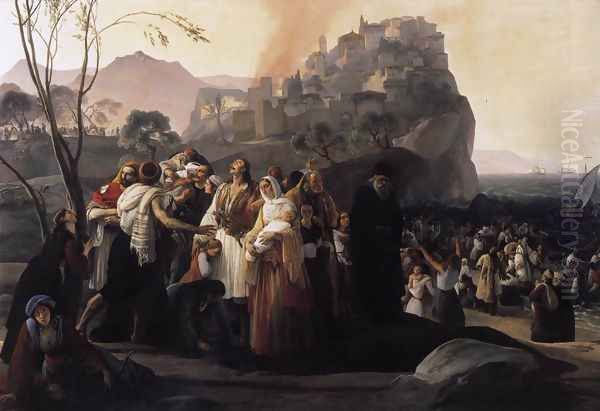
Another significant work from this period, The Sicilian Vespers (with several versions painted from the 1820s onwards), further cemented his reputation. This painting, depicting the 13th-century rebellion against French rule in Sicily, was rich in political allegory, subtly alluding to contemporary struggles against Austrian control in Lombardy-Venetia. Hayez's ability to infuse historical subjects with contemporary relevance and emotional intensity was a hallmark of his Romantic style.
The Brera Academy and Artistic Influence
Hayez's connection with the Brera Academy of Fine Arts (Accademia di Belle Arti di Brera) in Milan became a cornerstone of his career. He began teaching there in 1822, initially as an assistant, and was appointed Professor of Painting in 1850. He would later serve as its director from 1860 until his retirement in 1879. His long tenure at the Brera allowed him to exert a profound influence on several generations of Italian artists. He was a respected and admired teacher, known for his emphasis on drawing from life and his encouragement of individual expression, even as he maintained rigorous academic standards.
His students and followers included notable artists such as Giuseppe Molteni, a skilled portraitist and genre painter; Giovanni Carnovali, known as "Il Piccio," whose work displayed a more personal and almost impressionistic touch; and the Induno brothers, Domenico and Gerolamo, who became known for their patriotic genre scenes and depictions of the Risorgimento. Through his teaching and his own prolific output, Hayez helped to shape the course of Lombard Romantic painting. He was also an active participant in Milan's vibrant cultural life, frequenting literary salons, such as the one hosted by Clara Maffei, where he interacted with leading intellectuals, writers, and patriots, including Alessandro Manzoni and Giuseppe Verdi.
Masterpieces of Historical and Allegorical Painting
Throughout his career, Hayez produced a remarkable body of historical and allegorical paintings that captured the spirit of his age. The Refugees of Parga (1826-1831) is another powerful example. This large canvas depicts the tragic episode of the Pargiotes, forced to abandon their homeland to escape Ottoman rule. The painting is a poignant commentary on themes of exile, loss, and the struggle for freedom, subjects that resonated deeply with the Italian public. Hayez's meticulous attention to historical detail, combined with his ability to convey profound human emotion, made such works incredibly impactful.
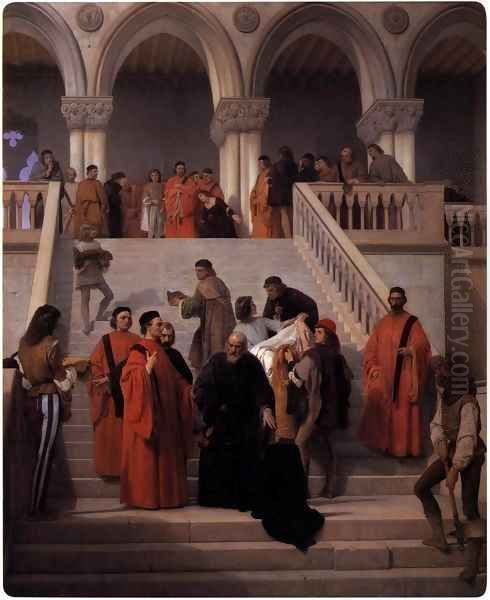
His historical paintings often drew upon medieval and Renaissance Italian history, imbuing these episodes with a sense of national pride and romantic drama. Works like The Last Moments of Doge Marin Faliero (1867) or scenes from the lives of figures like Carmagnola showcased his narrative skill and his ability to create compelling compositions filled with expressive figures. He also explored biblical themes, often infusing them with a similar dramatic intensity, as seen in Bathsheba at her Bath (various versions) or The Destruction of the Temple of Jerusalem (1867). These works demonstrated his versatility and his mastery of complex, multi-figure compositions.
The Power of Portraiture
Alongside his grand historical canvases, Francesco Hayez was one of the most sought-after portrait painters of his era in Italy. His portraits are characterized by their psychological insight, their elegant realism, and their ability to capture the sitter's personality and social standing. He painted many of the leading figures of Italian society, including aristocrats, intellectuals, artists, and patriots.
Among his most famous sitters were the writer Alessandro Manzoni, the composer Gioachino Rossini, the statesman Camillo Benso, Count of Cavour, and King Victor Emmanuel II. His portrait of Manzoni (1841) is particularly renowned for its sensitive portrayal of the great novelist. Hayez's portraits often went beyond mere likeness, offering a glimpse into the inner life of the subject. He employed a refined technique, with careful attention to texture, light, and the subtle nuances of expression. His female portraits, such as the Portrait of Countess Teresa Zumali Marsili with her Son Giuseppe or the enigmatic Valerie, the Sullen Girl, are celebrated for their grace and psychological depth. He often depicted women in contemporary attire, but also sometimes in historical or allegorical guise, blurring the lines between portraiture and genre painting.
Il Bacio (The Kiss): An Icon of Romanticism and Patriotism
Perhaps Francesco Hayez's most famous and enduring work is Il Bacio (The Kiss), painted in 1859. This painting, depicting a medieval couple locked in a passionate embrace, has become an iconic image of Italian Romanticism. The scene is set in a dimly lit, vaguely medieval interior, heightening the sense of intimacy and clandestine passion. The man, cloaked and spurred, seems poised for departure, suggesting a farewell kiss before a perilous journey or a secret meeting.
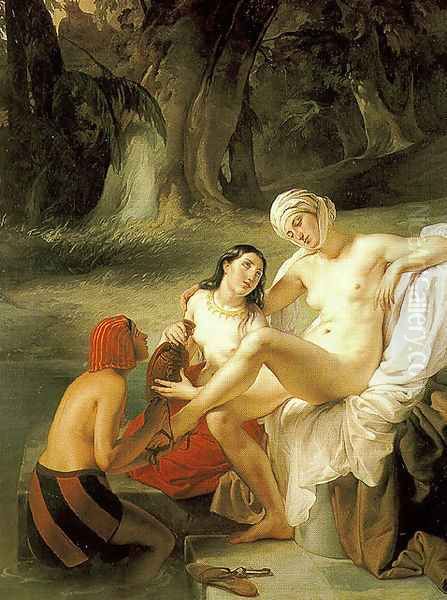
The Kiss is celebrated not only for its romantic intensity and technical brilliance but also for its potent political symbolism. Created in the year of the Second Italian War of Independence, which saw Lombardy liberated from Austrian rule and paved the way for Italian unification, the painting was widely interpreted as an allegory for the union of Italy and France against Austria. The colors of the figures' garments—the woman's blue dress and the man's red tights and greenish-brown cloak—have been seen by some as subtly alluding to the flags of Italy and France, allies in the struggle. Hayez painted several versions of The Kiss, with slight variations in color and composition, one of which (1861) more explicitly features the colors of the newly unified Italian flag. The painting's immediate and lasting popularity speaks to its powerful fusion of personal emotion and national aspiration. It remains one of the most reproduced and beloved images in Italian art.
Orientalist Themes and Sensual Beauty
Like many Romantic artists, including Delacroix and Ingres, Hayez was also drawn to Orientalist themes, depicting scenes inspired by the cultures of the Middle East and North Africa. These works often featured odalisques, harem scenes, and exotic settings, reflecting a European fascination with the "Orient" as a realm of sensuality, mystery, and untamed passion. Paintings such as Odalisque (c. 1839) or Ruth (1835) showcase his skill in rendering rich textiles, opulent settings, and the female nude.
While these Orientalist works catered to the tastes of the time, Hayez imbued them with his characteristic attention to detail and a certain psychological depth. His nudes, whether in Orientalist settings or mythological scenes like Venus Playing with Two Doves (1830), are notable for their smooth, porcelain-like skin and idealized beauty, yet they often possess an undercurrent of melancholy or introspection that elevates them beyond mere decorative pieces. These works highlight Hayez's mastery of the human form and his ability to convey sensuality with elegance and refinement.
Later Years and Enduring Legacy
Francesco Hayez continued to paint prolifically into his old age, though his later works sometimes showed a decline in the inventive power of his peak years. He remained a revered figure in the Milanese art world and a symbol of an era that had largely passed by the time of his death. The rise of new artistic movements, such as Realism and the Macchiaioli in Italy (artists like Giovanni Fattori and Telemaco Signorini), began to challenge the dominance of Romanticism.
Hayez passed away in Milan on December 21, 1882, at the venerable age of 91. He left behind a vast oeuvre, estimated at several hundred paintings, encompassing historical subjects, portraits, religious scenes, and allegories. His influence on Italian art was profound, particularly in Lombardy, where he helped to define the character of 19th-century Romantic painting. He successfully navigated the transition from the strictures of Neoclassicism to the emotional freedom of Romanticism, creating a body of work that was both technically accomplished and deeply resonant with the cultural and political aspirations of his time.
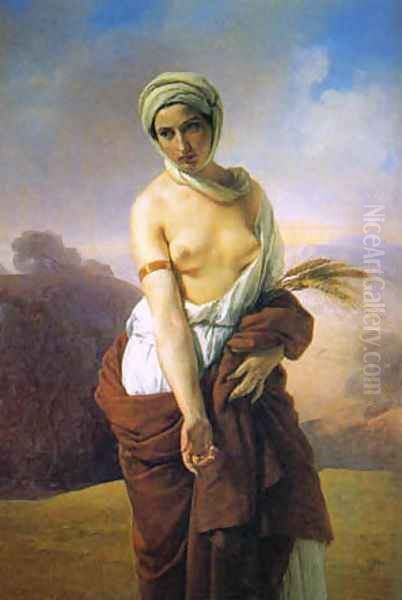
His contemporaries and artists who followed, such as Mosè Bianchi or Tranquillo Cremona (who developed a more Scapigliatura style), built upon the foundations laid by Romanticism, moving towards new forms of expression. However, Hayez's contribution remained fundamental.
Hayez in the Art Market and Public Collections
Francesco Hayez's works are highly prized in public and private collections. Major Italian museums, particularly the Pinacoteca di Brera in Milan, hold significant collections of his paintings. His works also appear in other prominent galleries across Italy and internationally. In the art market, Hayez's paintings, especially his major historical pieces and significant portraits, command high prices. The enduring appeal of works like The Kiss ensures his continued recognition. Recent auctions have seen his paintings, such as versions of Bathsheba, achieve multi-million dollar figures, underscoring his status as a key master of 19th-century European art. The historical significance of his subjects, combined with his artistic skill, contributes to their market value.
Conclusion: A Defining Voice of an Era
Francesco Hayez was more than just a painter; he was a chronicler of his times, an artist whose work encapsulated the ideals, passions, and struggles of 19th-century Italy. From his Neoclassical beginnings under the tutelage of Canova to his emergence as the foremost Romantic painter in Milan, Hayez consistently demonstrated a remarkable ability to connect with his audience on both an emotional and intellectual level. His historical paintings fueled patriotic sentiment, his portraits captured the essence of a generation, and works like The Kiss became timeless symbols of love and national identity. His long career at the Brera Academy ensured that his influence would extend to future generations, solidifying his place as a pivotal figure in the history of Italian art. Hayez's legacy is that of an artist who masterfully blended academic rigor with Romantic sensibility, creating a body of work that continues to captivate and inspire. He remains a testament to the power of art to reflect and shape the cultural and political landscape of an era.